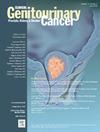卡博替尼在血管内皮生长因子靶向治疗(CASSIOPE)难治性晚期肾癌患者中的前瞻性非介入性现实世界研究
IF 2.3
3区 医学
Q3 ONCOLOGY
引用次数: 0
摘要
背景:目前还缺乏关于卡博赞替尼在晚期肾细胞癌患者既往血管内皮生长因子(VEGF)靶向治疗后的实际使用数据。CASSIOPE是一项真实世界的、前瞻性的、多中心的、非介入的授权后安全性研究,在欧洲,卡博赞替尼用于接受vegf靶向治疗的成年晚期肾细胞癌患者(NCT03419572)。终点包括卡博赞替尼的使用(由于不良事件引起的剂量变化[ae;主要终点]、剂量、剂量调整和治疗持续时间)、安全性、有效性(无进展生存期[PFS]、总生存期[OS]、最佳总缓解期[BOR])和医疗资源利用率。结果:全分析集(FAS)/安全人群共679例;其中433例起始剂量为60 mg/天(推荐剂量)的卡博赞替尼(主要安全人群)。中位年龄(FAS) 67岁(范围29 ~ 93岁);大多数为男性(73.3%),有透明细胞组织学(85.7%),卡博替尼起始时有转移性疾病(97.8%),既往有肾切除术(83%)。在主要安全人群中,77.1 %的人因AE而经历剂量调整。在安全人群中,中位日剂量为40.0(范围为7.8 ~ 600)mg/天,中位治疗持续时间为7.8(< 0.01 ~ 15.2)个月。治疗紧急事件发生率为95.9%,治疗相关事件发生率为90.9%。当地调查员采用任何方法评估的中位PFS (FAS)为8.3个月,1年OS率为74%。大约三分之一的患者有部分缓解的BOR, 6例有完全缓解。解释:二线或二线cabozantinib在现实环境中是有效和可控的,其安全性与先前的研究一致。本文章由计算机程序翻译,如有差异,请以英文原文为准。
A Prospective Non-interventional Real-World Study of cabozantinib in Pretreated Patients With Advanced Renal Cell Carcinoma Refractory to Vascular Endothelial Growth Factor-Targeted Therapy (CASSIOPE)
Background
There is a lack of published data on real-world cabozantinib use in patients with advanced renal cell carcinoma after prior vascular endothelial growth factor (VEGF)-targeted therapy.
Methods
CASSIOPE was a real-world, prospective, multicenter, non-interventional postauthorization safety study of cabozantinib in adult patients with advanced renal cell carcinoma in Europe following prior VEGF-targeted treatment (NCT03419572). Endpoints included cabozantinib utilization (dose modifications due to adverse events [AEs; primary endpoint], dose, dose modifications, and treatment duration), safety, effectiveness (progression-free survival [PFS], overall survival [OS], best overall response [BOR]), and healthcare resource utilization.
Findings
Full analysis set (FAS)/safety population comprised 679 patients; 433 of these initiated cabozantinib at 60 mg/day (recommended dose) (primary safety population). Median age (FAS) was 67 (range, 29-93) years; most were male (73·0%), had clear-cell histology (85·7%), metastatic disease at cabozantinib initiation (97·8%), and prior nephrectomy (80·3%). In the primary safety population, 77·1% experienced dose modification owing to an AE. In the safety population, the median daily dose was 40·0 (range, 7·8-60·0) mg/day and the median treatment duration was 7·8 (< 0·1-15·2) months. Treatment-emergent and treatment-related AEs were experienced by 95·9% and 90·4% of patients, respectively. Median PFS (FAS) assessed by the local investigator using any method was 8·3 months, and 1-year OS rate was 74%. Approximately one-third of all patients had a BOR of partial response and 6 had a complete response.
Interpretation
Second- or later-line cabozantinib was effective and manageable in a real-world setting and had a safety profile consistent with previous studies.
求助全文
通过发布文献求助,成功后即可免费获取论文全文。
去求助
来源期刊

Clinical genitourinary cancer
医学-泌尿学与肾脏学
CiteScore
5.20
自引率
6.20%
发文量
201
审稿时长
54 days
期刊介绍:
Clinical Genitourinary Cancer is a peer-reviewed journal that publishes original articles describing various aspects of clinical and translational research in genitourinary cancers. Clinical Genitourinary Cancer is devoted to articles on detection, diagnosis, prevention, and treatment of genitourinary cancers. The main emphasis is on recent scientific developments in all areas related to genitourinary malignancies. Specific areas of interest include clinical research and mechanistic approaches; drug sensitivity and resistance; gene and antisense therapy; pathology, markers, and prognostic indicators; chemoprevention strategies; multimodality therapy; and integration of various approaches.
 求助内容:
求助内容: 应助结果提醒方式:
应助结果提醒方式:


